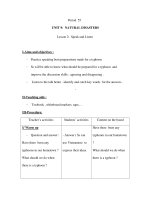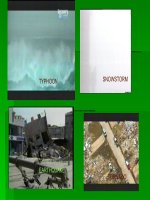- Trang chủ >>
- Đại cương >>
- Toán cao cấp
Unit 9 NATURAL DISASTER LESSON 4
Bạn đang xem bản rút gọn của tài liệu. Xem và tải ngay bản đầy đủ của tài liệu tại đây (54.36 KB, 3 trang )
<span class='text_page_counter'>(1)</span><div class='page_container' data-page=1>
<b>Unit 9: NATURAL DISASTERS</b>
<b> LESSON 4: READ</b>
<b>Aims: To give time for the students to practice their reading skill.</b>
<b>Objectives: By the end of the lesson the students will be able to read for specific information.</b>
<b>Skills: Reading, Writing, Speaking</b>
<b>Teaching aids: book, poster.</b>
Languages:
<b>Grammar:</b>
<b>Vocabulary: Pacific Rim, huge, strike, be collapsed, abrupt shift, erupt, scientist, </b>
funnel shape, suck up, baby carriage.
<b>TIME</b> <b>PROCEDURE</b> <b>T’S ACTIVITIES</b> <b>STS’ ACTIVITIES</b>
5’
<i><b>I.</b></i> <i><b>WARMER: Word picking out</b></i>
<i><b>Pick out the words that are about natural </b></i>
disasters.
Wave earth storm volcano rain tornado
drought mountain earthquake sea
tidal wave typhoon clouds
<b>Key: storm, volcano, tornado, drought, </b>
earthquake, tidal wave, typhoon.
- Controls the game - Play game
15’ <i><b>II.</b></i> <i><b>PRE-SPEAKING:</b></i>
<i><b>1.</b></i> <b>Pre teach vocabulary :</b>
- to occur /ə'kɜ:(r)/ = to happen /'h<sub></sub>pən/ =
to take place /teik pleis/ (v): xuất hiện
- the Pacific Rim /p<sub></sub>sifik 'rim/ (n): vành
đai lửa
- huge /hju:dʒ/ (adj) = very big: khổng lồ
- to strike /straik/ – struck /str<sub></sub>k/: tấn công
- to be collapsed /b<sub></sub> kə'l<sub></sub>pst/ (v): bị đổ sụp
- an abrupt shift /ə'brʌpt ∫ift/ (n): sự dịch
chuyển bất ngờ
- to erupt /i'rʌpt/ (v): phun trào
- a scientist /'saiəntist/ (n): nhà khoa học
- a funnel-shaped /'f<sub></sub>nl <sub></sub>eipt/ (n): có hình
phễu
- to suck up /sʌk <sub></sub>p/ (v): huùt
- a baby carriage /'beibi 'k<sub></sub>ridʒ/ (n): xe noâi
<b>Bingo :</b>
<i><b>2.</b></i> <b>Set the scene :</b>
We are going to read about some kinds of
natural disasters.
<i><b>3.</b></i> <b>True or False prediction </b>
- Follows the steps for
presenting vocabulary.
- Gives the common
idea of the lesson.
- Sticks the poster on the
board and run through.
- Listen and observe
what the teacher does.
- Listen
- Guess
Period: 61
</div>
<span class='text_page_counter'>(2)</span><div class='page_container' data-page=2>
<b>statements:</b>
a. Most of the earthquakes in the world occur
in the Ring of Fire.
b. The earthquake in Kobe in 1995 caused
severe damage.
c. A huge tidal wave traveled from California
to Alaska and hit Anchorage in the 1960s.
d. Typhoon, hurricane and tropical storm are
different words for the same natural disaster.
e. The eruption of Mount Pinatubo is the
world’s largest ever volcanic eruption.
f. A tornado looks like a funnel.
a b c d e f
15’
<i><b>III.</b></i> <i><b>WHILE- SPEAKING:</b></i>
<i><b>1.</b></i> <b>Read the passages and check the </b>
<b>T/ F:</b>
<b>Key:</b>
a b c d e f
<b>T T F T F T</b>
<i><b>2.</b></i><b>Read the passages again </b>
<b>carefully and complete the sentences page 79:</b>
(groups)
<b>Key:</b>
1. occur in the Ring of Fire.
2. people were killed.
3. there is an abrupt shift in the
underwater movement of the Earth.
4. Cyclone.
5. the meaning of the words Typhoon.
6. has the funnel-shaped/ looks like a
funnel.
- Gives time to read.
- Gives more time for
reading the passages
again, and fill in the
gaps
- Read and answer the
above statements are
True or false.
- Read the passages
again carefully and fill
in the gaps with
suitable information
4’
<i><b>IV.</b></i> <i><b>POST- SPEAKING:</b></i>
<i><b>Discussion</b></i>
Do you know “What is the name of the volcano
that erupted in 79 A.D and destroyed Pompeii?”
- Gives time and
question to discuss.
- Discuss with partner.
1’
<i><b>V.</b></i> <i><b>HOMEWORK:</b></i>
- Learn the lesson carefully.
- Prepare for the next lesson.
- Gives home
assignment
- Take notes
<b>Notes :</b>
</div>
<span class='text_page_counter'>(3)</span><div class='page_container' data-page=3></div>
<!--links-->









